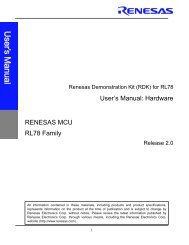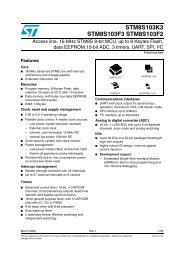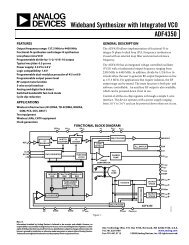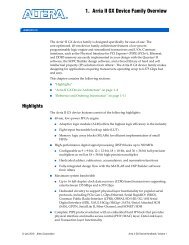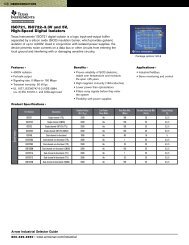Amplifier and Data Converter Selection Guide (Rev. B
Amplifier and Data Converter Selection Guide (Rev. B
Amplifier and Data Converter Selection Guide (Rev. B
- No tags were found...
Create successful ePaper yourself
Turn your PDF publications into a flip-book with our unique Google optimized e-Paper software.
<strong>Amplifier</strong>s47TI has achieved significant advancement inlog amp technology. The logarithmic amplifieris a versatile integrated circuit that computesthe logarithm of an input current relative to areference current or the log of the ratio oftwo input currents. Logarithmic amplifierscan compress an extremely wide inputdynamic range (up to 8 decades) into aneasily measured output voltage. Accuratematched bipolar transistors provide excellentlogarithmic conformity over a wide inputcurrent range. On-chip compensation achievesaccurate scaling over a wide operatingtemperature range.TI log amplifiers are designed for opticalnetworking, photodiode signal compression,analog signal compression <strong>and</strong> logarithmiccomputation for instrumentation. Some logamps, such as the LOG102, feature additionaluncommitted op amps for use in a variety offunctions including gain scaling, inverting,filtering, offsetting <strong>and</strong> level comparison todetect loss of signal. The LOG2112 is a dualversion of the LOG112 <strong>and</strong> includes two logamps, two uncommitted output amps <strong>and</strong> asingle shared internal voltage reference.Design ConsiderationsOutput scaling—amplifier output is0.32V, 0.5V or 1.0V per decade <strong>and</strong> is theequivalent of the gain setting in a voltageinput amp.Logarithmic <strong>Amplifier</strong>sQuiescent current—lowest in LOG101 <strong>and</strong>LOG104.Conformity error—measured with 1nA to1mA input current converted to 5V output.More than 16-bits of dynamic range areachievable.Auxiliary op amps—some log amps haveadditional uncommitted op amps that can beused to offset <strong>and</strong> scale the output signal tosuit application requirements.Technical InformationLog amplifiers provide a very wide dynamicrange (up to 160dB), extremely good DCaccuracy <strong>and</strong> excellent performance overthe full temperature range.➔R 1R 2V LOGOUT = (0.5V)LOG (I 1 /I 2 )CV CO3 = K (0.5V)LOG (I 1 /I 2 ), K = 1 + R 2 /R 1A 3I 1R REFV+Q 1 Q 2AI 1A 22V REFV +IN3–IN3LOGOUTV O3LOG112 Key Features• Easy-to-use complete function• Output scaling amplifier• On-chip 2.5V voltage reference• High accuracy: 0.2% FSO over 5 decades• Wide input dynamic range:7.5 decades, 100pA to 3.5mA• Low quiescent current: 1.75mA• Wide supply range: ±4.5V to ±18V• Packaging: SO-14 (narrow) <strong>and</strong> SO-16V REFV REF – GNDV CMGNDV–NOTE: Internal resistors are used to compensate gain change over temperature.The V CM pin is internally connected to GND in the LOG2112.LOG112 functional block diagram.Logarithmic <strong>Amplifier</strong>s <strong>Selection</strong> <strong>Guide</strong>ConformityConformityInput Input Error Error I QCurrent Current (Initial 5 (Initial 5 PerScale Range Range Decades) Decades) V S V S Ch.Factor (nA) (mA) (%) (%/°C) B<strong>and</strong>width (V) (V) (mA) Reference AuxiliaryDevice (V/Decade) (min) (max) (max) (typ/temp) (kHz) (min) (max) (max) Type Op Amps Package Price *LOG101 1 0.1 3.5 0.2 0.0001 38 9 36 1.5 External — SO-8 $6.95LOG102 1 1 1 0.3 0.0002 38 9 36 2 External 2 SO-14 $7.25LOG104 0.5 0.1 3.5 0.2 0.0001 38 9 36 1.5 External — SO-8 $6.95LOG112 0.5 0.1 3.5 0.2 0.00001 38 9 36 1.75 2.5V Internal 1 SO-14 $7.90LOG2112 0.5 0.1 3.5 0.2 0.00001 38 9 36 1.75 2.5V Internal 1/Ch SO-16 $11.35LOG114 .375 0.1 10 0.2 0.001 5000 5 10 10 2.5V Internal 1 QFN $7.90* Suggested resale price in U.S. dollars in quantities of 1,000. New products are listed in bold red.Texas Instruments 3Q 2007<strong>Amplifier</strong> <strong>and</strong> <strong>Data</strong> <strong>Converter</strong> <strong>Selection</strong> <strong>Guide</strong>






